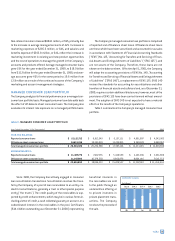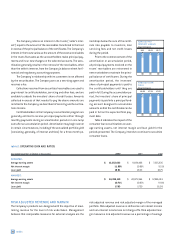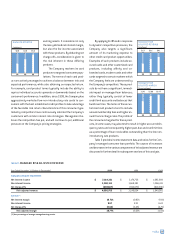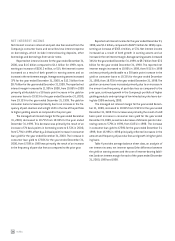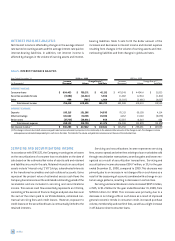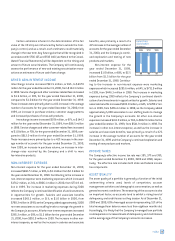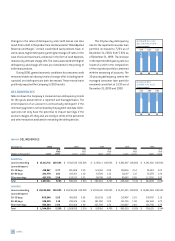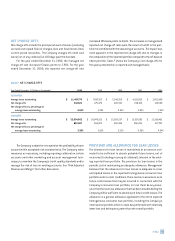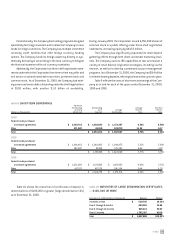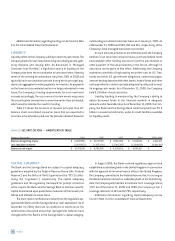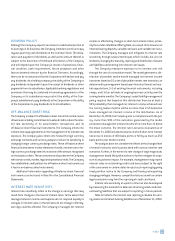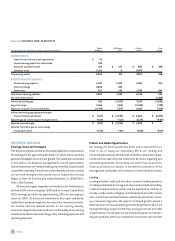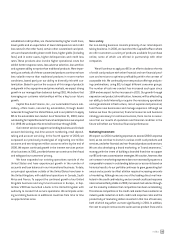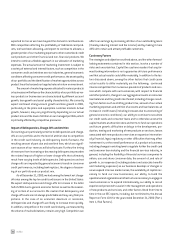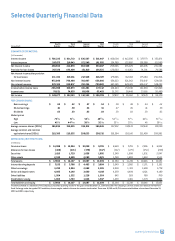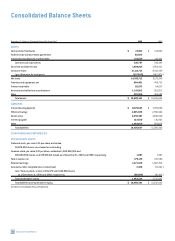Capital One 2000 Annual Report Download - page 36
Download and view the complete annual report
Please find page 36 of the 2000 Capital One annual report below. You can navigate through the pages in the report by either clicking on the pages listed below, or by using the keyword search tool below to find specific information within the annual report.
34 md&a
The amount of allowance necessary is determined primarily
based on a migration analysis of delinquent and current accounts.
In evaluating the sufficiency of the allowance for loan losses, man-
agement also takes into consideration the following factors: recent
trends in delinquencies and charge-offs including bankrupt,
deceased and recovered amounts; historical trends in loan volume;
forecasting uncertainties and size of credit risks; the degree of risk
inherent in the composition of the loan portfolio; economic condi-
tions; credit evaluations and underwriting policies. Additional
information on the Company's allowance for loan loss policy can be
found in Note A to the Consolidated Financial statements.
Table 8 sets forth the activity in the allowance for loan losses
for the periods indicated. See "Asset Quality," "Delinquencies" and
"Net Charge-Offs" for a more complete analysis of asset quality.
FUNDING
The Company has established access to a wide range of domestic
funding alternatives, in addition to securitization of its consumer
loans. In June 2000, the Company established a $5.0 billion global
senior and subordinated bank note program, of which $994.8 mil-
lion was outstanding as of December 31, 2000, with original terms
of three to five years. In February 2001, the Company issued an
additional $1.3 billion fixed rate senior global bank note with a term
of five years. The Company has historically issued senior unsecured
debt of the Bank through its $8.0 billion domestic bank note pro-
gram, of which $2.5 billion was outstanding as of December 31,
2000, with original terms of one to ten years.
table 8: SUMMARY OF ALLOWANCE FOR LOAN LOSSES
Year Ended December 31 (Dollars in Thousands) 2000 1999 1998 1997 1996
Balance at beginning of year $ 342,000 $ 231,000 $ 183,000 $ 118,500 $ 72,000
Provision for loan losses 718,170 382,948 267,028 262,837 167,246
Acquisitions/other (549) 3,522 7,503 (2,770) (18,887)
Charge-offs (772,402) (400,143) (294,295) (223,029) (115,159)
Recoveries 239,781 124,673 67,764 27,462 13,300
Net charge-offs (532,621) (275,470) (226,531) (195,567) (101,859)
Balance at end of year $527,000 $ 342,000 $ 231,000 $ 183,000 $ 118,500
Allowance for loan losses to loans at end of year 3.49% 3.45% 3.75% 3.76% 2.73%
For the year ended December 31, 2000, the provision for loan
losses increased 88% to $718.2 million from the 1999 provision for
loan losses of $382.9 million as a result of an increase in average
reported loans of 50%, continued seasoning of the reported portfo-
lio and the shift in the mix of the composition of the reported
portfolio. As a result of these factors, the Company increased the
allowance for loan losses by $185.0 million during 2000.
For the year ended December 31, 1999, the provision for loan
losses increased 43% to $382.9 million from the 1998 provision for
loan losses of $267.0 million as average reported loans increased
43%. The Company increased the allowance for loan losses by
$111.0 million during 1999 due to the increase in the delinquency
rate, the growth in the reported loans and the increase in the dollar
amount of net charge-offs.



